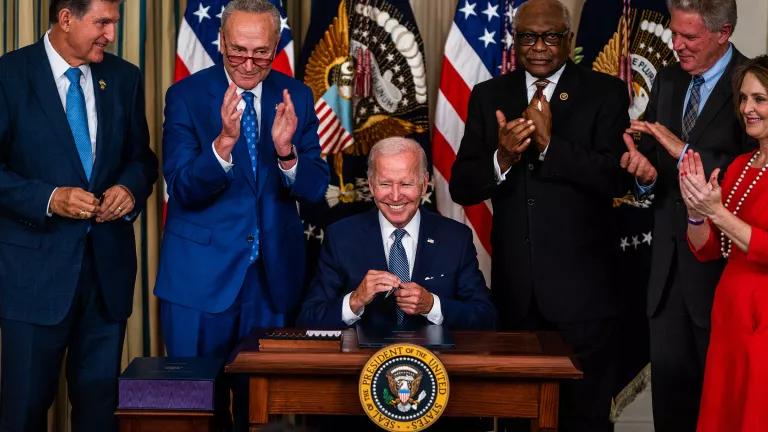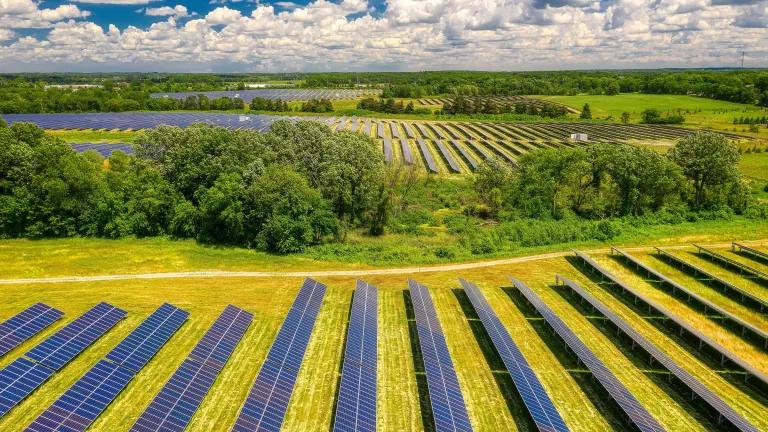
J.D. Crowe. Reprinted with permission. Originally printed in the Los Angeles Times.
The Trump Administration today directed federal agencies to begin rolling back commonsense clean car and fuel economy standards. As part of the first step to weakening the standards, the U.S. Environmental Protection Agency (EPA) under Administrator Scott Pruitt and Department of Transportation under Secretary Elaine Chao, issued a Notice of Intent to reconsider the standards. The reopening signals a complete 180 on years of technical and scientific review by both agencies, which found the standards could be met on time, with known technologies, and at reasonable cost. As NRDC President, Rhea Suh, stated:
This change makes no sense. Mileage standards save consumers money at the gas pump, make Americans less dependent on oil, reduce carbon pollution and advance innovation. The current standards helped the auto companies move from bankruptcy to profitability, and there is no reason they cannot be met. This is just another part of President Trump’s retreat from action on climate change.
Several news articles have reported that as a next step, the Trump Administration may target California’s ability to implement its Clean Cars Program (here, here, and here) by rescinding a past waiver EPA has granted the state, which allows it to adopt stricter than federal standards. This would have broad national implications, because 12 other states, together with the District of Columbia, have also adopted California’s Clean Cars standard to protect their citizens. All told, the standards are benefiting 113 million U.S. residents (or 35 percent of the U.S. population) and covering 35 percent of the passenger vehicle market.
California has regulated vehicle emissions for many decades to tackle air quality and public health threats―starting long before the federal government stepped in or EPA was created. The Golden State has authority to take the lead on motor vehicle pollution under the federal Clean Air Act. Given his vocal support for “states’ rights,” we would expect EPA Administrator Pruitt to be a supporter of California’s and other states’ authority to take the lead on controlling motor vehicle pollution. How would he explain denying California that right in favor of protecting car companies and fossil fuel interests? The Clean Air Act creates the strongest possible presumption in favor of California’s clean car program. If the Trump Administration attacks California, it should be prepared for a long, arduous uphill battle in the courts, and in the court of public opinion.
Long, Uphill Climb Toward a Dead-End
California’s Clean Cars Program cannot be undone by the stroke of a pen. Trump can't kill it by Executive Order, nor can Pruitt by an internal memo. In the last 50 years, EPA has issued California over 100 waivers to set and enforce stringent clean air standards, or issued confirmations that rulemakings fell within the scope of previously issued waivers. None have ever been revoked. If a Clean Air Act waiver can be revoked at all, that could only happen through a notice and comment rulemaking by the EPA in compliance with the Clean Air Act and federal administrative law, and a decision to revoke is 100 percent certain to be litigated
The authority under the Clean Air Act allows California to set stricter than federal standard to protect California citizens―as well as other states to adopt those stricter standards. An EPA decision to revoke the waiver would be litigated forcefully by California, NRDC, and many others. The process will take years, not days, weeks or months, to resolve.
In addition, by blowing up the coordinated National Program of clean car and fuel economy standards―agreed upon in 2011 by automakers, EPA, U.S. Department of Transportation (DOT), California, and the United Autoworkers union and finalized in 2012―automakers and their suppliers will face many years of regulatory and product planning uncertainty. This move will hurt jobs, as investments from suppliers and automakers slow in the face of business uncertainty. That’s why a survey of major auto suppliers has shown that 70 percent do not want policymakers to change standards. Hundreds of thousands of American workers, located at over 1,200 facilities in 48 states, are today building technologies that improve fuel economy and lower carbon pollution―a phenomenon driven in large part thanks to strong standards.
“Alternative Facts” Won’t Fly
At the request of the automakers, the stricter California rules for 2022-2025 were negotiated in coordination with EPA’s national clean car standards. Both EPA and California, with years of input from automakers, technology experts, non-profit groups, and the public, have shown that those national standards can be met, as my colleague Luke Tonachel has written here. For that reason, the EPA would need to give strong reasons―not new alternative facts―why it will pull back and change the established standards.
Weakening California’s Standards Would Affect More Than 113 Million Americans
Finally, let's remember what's at stake. Undoing California’s clean car standards in addition to the national standards will threaten the health and wallets of people around the state and nation. For decades, California has led the nation in enforcing clean car standards. Time and again, other states and the federal EPA have adopted the emission controls first proven feasible and beneficial in California. State and federal standards have saved tens of thousands of lives and avoided hundreds of billions of dollars in health-related costs.
Under its standards, California, home to six of the ten most polluted cities in the country, will continue to see improvements to public health, avoiding thousands of asthma attacks, emergency room visits, and premature deaths attributed to vehicle emissions. By attempting to rollback state standards, the administration would also be threatening technology progress. Under the standards, by 2025 new vehicles would emit 75 percent less smog-forming pollutants and nearly 50 percent less greenhouse gas emissions versus those produced just five years ago. And that technology will spread nationwide.
Car owners are also reaping significant fuel savings. The owner of a vehicle meeting the 2025 standards will save on average $4,000 overall compared to a new vehicle today, even accounting for the additional cost of the advanced technology in the car. Consumers that finance or lease vehicles start seeing net savings in the first month they have their new cars. As Consumers Union has shown, the standards have been a boon even for low-income households. Automakers are also introducing the new technologies needed for a clean energy future. In just six years automakers have introduced over 30 electric-drive models with those numbers expected to grow to 70 models over the next five years, providing consumers with cleaner, more efficient choices.
California’s right to protect its citizens with cleaner vehicles has been part of the Clean Air Act for 50 years. It’s a right that has been upheld by the courts time and time again. Without California’s leadership, Americans would still be stuck with heavily polluting vehicles and suffering from more climate-wrecking pollution.
Simply put, attacking federal and state clean car standards is a loser.




